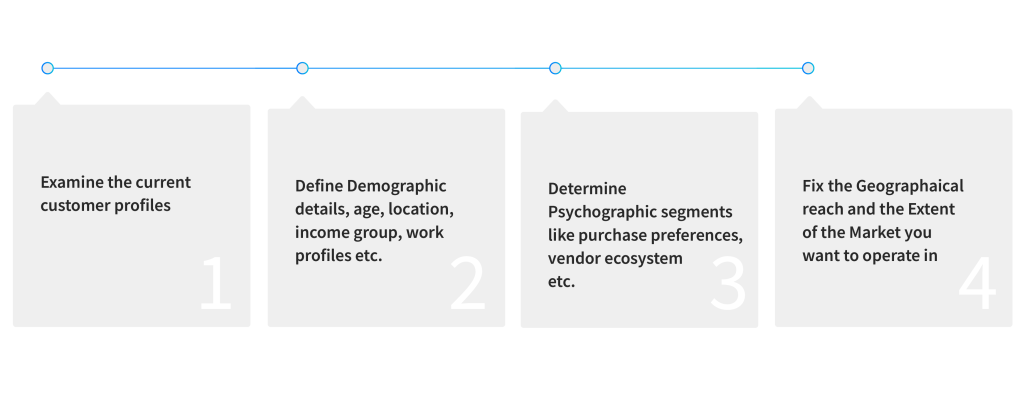The Marketing Paradox
Marketing is a very infinite term, don’t you think? How will one know what the sequence of marketing programs should be? One might think that running digital campaigns will be more effective than outbound reach methods. Some might reckon that BTL activities like webinars and workshops, will have a more direct impact. Over and above all this, you might wonder, when will the actual functions like sales, PR, branding, and advertising come into play? Is there a marketing barometer to check the lengths and breadths of promotional programs? Should it be an ongoing process, or should it stop once your work model is in sustenance mode? Likewise, there are a few bewildering questions you should brainstorm before executing your campaigns. Hence, your campaign objectives need to be discernible.
A big challenge is how to single out the right buyer persona for your brand’s offerings. All your marketing efforts will go in vain if you are preaching to the wrong audience.
Many similar apprehensions and miscalculations can baffle you beyond limits. You can get bogged down, because you might be expecting different outcomes from similar campaigns. Sometimes, due to extremely ambitious marketing drives, companies incur massive losses.
How do you avoid the Marketing Dilemma?
First and foremost, let’s get rid of one mindset. If everyone is doing it, it should be right. This idea won’t always hold water, if you are expanding to new regions. For instance, IT companies apply different marketing strategies for different regions. In the Indian Market, email marketing is a major strategy for the southern regions, whereas for the west and northerns parts, social media marketing might be more predominant. Likewise, some might start with Google display ads, and some might organize seminars or webinars for a niche technical product.
The only thing that can be standardized is your target audience portfolio and where they are located. You need to dive deeply into the dynamics of the business environment of the region you are targeting and observe live case studies from it.
Moreover, you will need a seasoned marketer who has been conducting campaigns in the said territory, to design a digital roadmap for you. Not to mention, a good marketing partner will have relevant lead databases. A marketing collaboration will only work to your advantage.
The Tangent Approach
In B2B industry verticals, it boils down to one thing only, which is to pinpoint your real target group. We often erroneously position our offerings in a broader target category. When an organization is spreading its wings to fly to new territories, the customer-centric approach becomes even more critical. The following could be a fitting framework to work upon.
Marketing Universe Profiling Process

Know Marketing Objectives Consciously
There is no better way to say this. If you are running random campaigns without the clarity of your marketing objectives, it’s just a shot in the dark. Your campaigning goals must be lucid and definite. You need to ask yourself, what is it that you want to achieve? Is it brand awareness, lead generation, increased sales or just website traffic? Whatever your end goal is, the campaign/campaigns have to be strategized accordingly.
Understanding the Purchase Drivers
In B2B businesses there are some external factors at play. The purchase drivers can massively impact the customer’s buying patterns even beyond the utility benefits of any product or service. The usage might not even be associated with a particular brand. Other priorities like familiarity, convenience, value equation, after-sale service etc. can take over. These factors become a deeply ingrained SOP (Standard Operating Procedure), over time. That is why you need to understand the drivers, which affects the customers’ decision-making process.
To attract repeat business, you should be able to read between the lines and see the underlying reasons behind the current purchase decisions. Ideally, building a loyal customer base should be the overriding goal of any marketing activity.
Broaden your existing network
How about starting with people you already know? Create a bond with them and let them know that you appreciate the ongoing business association with them. Get to know if they have operational sister concerns, or any referral leads from their industry fraternity. Gain market intelligence from them and ask for any new ventures they might know, who could be your potential buyers.
Liaison with internal experts
You need to address a universe from your company’s perspective. The combined experience of your team is your biggest asset. Take notes on which companies should be pursued for future business and know more about the companies that are on the verge of closure.
Garner relevant information
You need to be more vigilant and well-versed with your future customer in and out. You need to know where they are headquartered, their annual, half-yearly or quarterly budget plans, current vendor/vendors etc. The more you know, the more likely it is to work your way around converting them.
Know the Key Influencer
Every department has a key influencer who has a big say in the procurement process of their respective departments. If the procurement is for technical products, the role of a key influencer becomes even more critical. For instance, no one will know better than an IT Manager which configuration laptops or desktops are most compatible with the IT environment of their companies. They ought to have brand preferences too and it can be a tough sell if the key person is not convinced by the quotation.
The Take-Home message
The above factors might sound trivial while strategizing for expansion or customer retention, but if they are inculcated in the work culture, it will work wonders and, more importantly, it will improve your business relationships, presence and even, instate market dominance.

